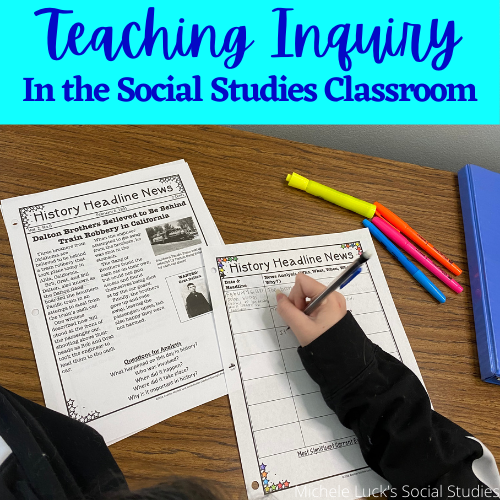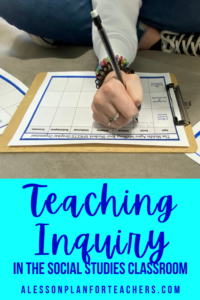Some states are adopting an inquiry design model for teaching Social Studies for primary, middle, and high school students. While this approach is definitely a model we should all be following, we should take it a step further. We should be teaching inquiry by presenting resources in a way that allows students to learn the inquiry process themselves.

Questioning is fundamental. If we teach students how to create their own questions and ask questions for deeper understanding, it is the basis of analysis. Setting them up for success is easy when teaching these basic inquiry skills (and lots of practice). It is more like teaching the student to fish instead of handing them a piece of fried cod. We are setting them up for a lifetime of questioning and analysis, which will benefit them through college and beyond.

Tips for Promoting Inquiry in Your Classroom
- Firstly, use visuals to encourage student interest.
- Find chunked reading or other content that can lead to greater engagement.
- Provide broad topics or questions that students can evaluate for deeper questioning.
- Allow students to be wrong and reinforce questioning for the purpose of study.
- Set up opportunities for collaborative work where students can develop and ask questions for analysis of topics.
- Utilize processing activities that will require students to ask questions to break down information.
- Most importantly, introduce inquiry and questioning in every lesson you do. This will get students used to asking questions to delve deeper into the content they are presented with in lessons.
Great News About Teaching Inquiry
- Firstly, and most exciting – it does not require you to rewrite your curriculum.
- It allows you more time and freedom in the classroom.
- Teaching inquiry is more engaging for students.
- It works well with resources you already have on hand.
- Lastly, it will create a classroom atmosphere where students feel more accepted and included in the learning process.

Your existing curriculum can absolutely be used to include inquiry! But, there are also many ready-made resources at your fingertips. Including inquiry-based lessons in your units can ensure students engage with the lessons in the best way possible. Try some of these resources for inquiry-based teaching.
Religion Analysis Through the Middle Ages
Analysis can be taught at any age! Even elementary students can learn analysis with History Headline News.
Happy Teaching!
